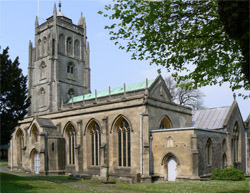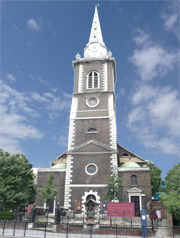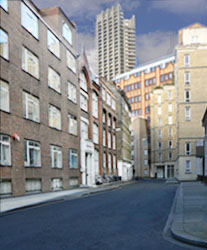| Benjamin Follett Scadding
1784-1857 |
 |
St Peter and St Paul's Church,
Shepton Mallet in 2007 |
|
Benjamin Follett SCADDING, was born in about 1784 and baptised on 5 January 1785 in Ilchester, Somerset. He was the second son of Daniel Follett SCADDING (1760-1821), a Coroner for the County of Somerset and his wife Elizabeth BROWN. Nothing is currently known about Daniel's elder brother, Joseph Brown Scadding and he may have died as an infant. Although born in Ilchester, Benjamin probably spent the first few months of his life in Glastonbury, where his father was the Town Clerk, before spending the rest of his childhood in Shepton Mallet in Somerset. The family were living in Shepton Mallet in 1793 when Benjamin's two younger brothers were baptised. Francis had been born in 1790 and Richard in 1793 and it was most likely a fairly comfortable childhood given his father's important and respected Coroner's job.
When he was about 26 years old Benjamin was in Bristol, where on 10 September 1811 in St Michael’s Church, he married Hannah ROLPH, a sixteen year old local girl.
Their first child, Elisabeth was born in 1814 in Somerset but by the time their second daughter, Sarah Susan, was born the following year the young family had moved to London. Sarah was born on 14 May 1815 in Princes Square, London and was baptised on 13 August 1815 in the church of St George in the East, Middlesex. At that time Benjamin was working as a carpenter.
Henry Peto and the Custom House
Benjamin stayed in the building trade but moved on to being a clerk. On 2 July 1817 he was a Clerk to Mr Henry Peto, a building contractor, when he gave evidence at the Old Bailey in the case of George Davidson who was accused of stealing from his employer, Henry Peto. At that time Mr Peto was working as the contractor for building the New Custom House. It was not going well: the project had been behind schedule from the first winter when the Thames froze, temporarily halting work on the foundations, and there were financial difficulties due to Peto's underpriced tender for the work being less than three-quarters of the designers estimated cost. The pressure was on when the old Custom House burnt down in 1814 but the Board of Commissioners were not able to move in until May 1817. There were enquiries into the causes of the fifteen month delay and the behaviour of the contractors but eventually in November 1817 the work was finished. Less than three years later cracks started to appear in the building and plaster fell from the ceiling, and in 1825 part of it collapsed. When the foundations were examined it was found that there had been much sub-standard work and the materials were neither of a size nor quality to that which had been ordered and paid for. Peto was discredited but it did not seem to reflect on Benjamin who soon after was describing himself as a Gentleman.
|
|
St George in the East, London |
Benjamin and Hannah had their first son, Daniel Benjamin, on 25 March 1817 in the area of St George in the East in Middlesex. Another son, George Rolph, was born on 12 December 1818 in Princes Square, London and both boys were baptized on 24 January 1819 in the Parish church of St George in the East whilst their father was still working as a clerk. Their address was given as Princes Square, Town Chapman Street.
 |
St Botolph, London |
|
By the time their son, Edward, was born in 1821 the family had moved to Clerkenwell and within two years had moved again to Aldersgate. More children followed at regular intervals; Hannah was born on 12 February 1823 and was baptised on 17 September 1823 in St Botolph Without Aldersgate, London; Emma was born on 9 November 1825 and Frederick on 25 August 1827 in Aldersgate. They were baptized together on 20 September 1827 in the same church as Hannah had been baptised.
A few days after Frederick was born the family were living at 35 Edmund Place, Aldersgate Street, Aldersgate, London, a brick built house. Benjamin described himself as a ‘Gentleman’ when on 29 August 1827 he went to the Sun Fire Office in London, Middlesex to insure his "household goods, wearing apparel, printed books and plate" for £300.
Their last child, Eliza, was born on 29 November 1830 but she was not a healthy baby. She was baptised on 29 December 1830 in St Botolph Without Aldersgate but four days later she died of emphesema and bronchitis.
By 9 September 1835 Benjamin and his family had moved the short distance from Edmund Place to 24 Bartholomew Close, St Bartholomew the Great, London where he continued to live until the last year or so of his life.
Bartholomew Fair
The area is famous for the Bartholomew Fair, an important annual social event. By 1835 many of the great London fairs had ceased but the Bartholomew Fair was one which had survived. It was held in the Smithfield Market in early September and following the opening by the The Lord Mayor amidst great pomp and circumstance, reportedly, attracted 100,000 people per day for each of its three days. The fair attracted all people regardless of class and it was one of the few occassions when the poor rubbed shoulders with the rich. Here the apprentices and servants enjoyed themselves in the same place as their employers, and the theives and pickpockets found it a very lucrative time! Originally a cloth fair, by Benjamin's time it was a place of entertainment and enjoyment, with delicious food for sale and shows to visit. The local inns did a roaring trade as the visitors stopped on their way to the fair, no doubt arriving in a merry state and drunken fights were common and inevitable as people let their hair down for a few days. The attractions included Punch and Judy shows, acrobats, Wombwell's circus, various "freak" shows, toy stalls and gambling booths. Benjamin and Hannah almost certainly took their family to the fair each year and joined in with the carnival atmosphere. As the fair became more rowdy complaints started to arrive and over the next twenty years the fair gradually got smaller until, in 1854, the last Bartholomew Fair was held.
In the census of 1841 Benjamin was recorded as a clerk but later the same year he was described as a builder when his daughter Sarah married John Finlay Miller on 16 September 1841 in St Bartholomew the Great. Benjamin was at the wedding and signed as a witness.
 |
Part of Bartholomew Close
in 2008 |
|
On 28 February 1843 Benjamin was a surveyor. He appeared in the census on 30 March 1851 as still living in Bartholomew Close where he was again described as a surveyor. There were several lodgers and visitors with the family because Benjamin and Hannah were supplementing the family income by letting out rooms. In the Post Office Directory of 1852 Benjamin's address is listed as a lodging house. Nowadays Bartholomew Close is within the boundary of Barts Hospital but a picture by John Wykeham Archer painted in 1850 in the British Museum shows part of St Bartholomew Close as an assortment of rickety three storey houses around a public house, possibly the Coach and Horses, and a wooden stable. The 1851 census indicates many crowded houses in the close with an above average number of book binders living there.
The West London Union Workhouse
Some time between 1 January 1856 and 1 April 1856 Benjamin was admitted to the West London Union Workhouse. He was in good health except that, for about the last six months, he had been suffering from a "defective memory". The medical Officer, Stephen John Burt, considered him to not be dangerous and indeed Benjamin was most likely suffering from some form of dementia and his family could no longer take care of him. By the 1 January 1857 his physical health had deteriorated and he was suffering from bronchitis. His health deteriorated further and on 15 March he died, not of bronchitis but of "general decay" and "diarrohea". He was 73 years old, not considered so old nowadays but a good age in the mid 1800s.
Four months after Benjamin's death Hannah caught bronchitis. When she died, a week later, her daughter Sarah Susan was there with her and later registered her as the widow of Benjamin Follett Scadding, architect.
Copyright
Photographs copyright Pauline Leggat 2009
Copyright Pauline Leggat 2009
Sources and Notes
[1] Scadding Family website [online], [Accessed 1 April 2009] Available at http://www.scadding.net/families/Somerset.html
[2] Ilchester baptisms D/P/ilch 2/1/2, Somerset Record Office, Taunton
[3] Dunning, Robert,Why have a mayor for Glastonbury? [online]. [Accessed 1 April 2009]. Available at: http://web.ukonline.co.uk/jim.nagel/ap/consoc/dunning.html
[4] FreeREG, Births, Shepton Mallet [online]. [Accessed 24 August 2004]. Available at: http://freereg.rootsweb.com
[5] Writ for a new coroner of Somerset 1784, National Archives Kew, Reference C 202/172/13
[6] IGI Extract from parish registers [online]. [Accessed 2008]. Available at: http://www.familysearch.org/
[7] 1851 England Census [online]. [Accessed 2009]. Available at: http://www.ancestry.co.uk
[8] St George in the East, Parish Records, London Metropolitan Archives.,
[9] St George in the East, Parish Records Reference X097/278. London Metropolitan Archives.
[10] St George in the East, Parish Records Reference X097/278. London Metropolitan Archives.
[11] St George in the East, Parish Records Reference X097/278. London Metropolitan Archives.
[12] IGI Extract from parish registers [online]. [Accessed 2008]. Available at: http://www.familysearch.org/
[13] IGI Extract from parish registers [online]. [Accessed 2008]. Available at: http://www.familysearch.org/
[14] IGI Extract from parish registers [online]. [Accessed 2008]. Available at: http://www.familysearch.org/
[15] Sun Fire Offfice Records, Reference MS 11936/512/1065293, 29 Aug 1827, Guildhall, London.
also Sun Fire Offfice Records, Reference MS 11936/546/1204316 9 September 1835, Guildhall, London.
[16] IGI Extract from parish registers [online]. [Accessed 2008]. Available at: http://www.familysearch.org/.
[17] 1851 England Census [online]. [Accessed 2009]. Available at: http://www.ancestry.co.uk
[18] St Bartholomew the Great Parish Records, The Guildhall, London
[19] St Matthew Bethnal Green Parish Records Reference X025/014 (Daniel Benjamin's marriage), London Metroploitan Archives
[20] 1851 England Census [online]. [Accessed 2009]. Available at: http://www.ancestry.co.uk
[21] West London Union, quarterly returns, London Metropolitan Archives
[22] Death Certificate of Benjamin Scadding. General Register Office, England
[23] Death Certificate of Hannah Scadding. General Register Office, England.
Additional sources
The Proceedings of the Old Bailey Ref: t18170702-136 [online], [Accessed 2 April 2009]. Available at: http://www.oldbaileyonline.org
The West Street Workhouse [online], [Accessed 2 April 2009]. Available at: http://www.workhouses.org.uk/index.html?WestLondon/WestLondon.shtml
The Custom-House - Mr Peto, Hansard 15 April 1825, [online], [Accessed 2 April 2009], Available at: http://hansard.millbanksystems.com/commons/1825/apr/15/the-custom-house-mr-peto
Crook, J. Mordant,
The Custom House Scandal, Architectural History, Vol. 6, (1963), pp. 91-102, Published by: SAHGB Publications Limited, [online], [Accessed 2 April 2009], Available at: http://www.jstor.org/stable/1568284
Post Office Directories of 1841 and 1852
Grant, James. Sketches in London, 1838.
[online], [Accessed 9 April 2009] Available at: http://www.victorianlondon.org
Morley, Henry. Memoirs of Bartholomew Fair, [online], [Accessed April 2009] Available at: http://books.google.co.uk/books
Links
The Cameo of Edward Scadding, Benjamin and Hannah's son
The Cameo of Joseph Scadding, Benjamin's great grandfather
Updated 10 September 2009
|